Seville is Andalusia’s main city and Spain’s fourth largest city. Some say that this lively, joyous and romantic destination is the reflection of the essence of Spain. With a vast heritage and historical legacy, Seville is home to the largest Gothic building in the world – the Cathedral, a symbol of Christianity. This vibrant city is rich in culture and tradition, and is known for its delicious cuisine and flamenco dancing. Strolling through the picturesque and narrow streets of its historic center and across the marvelous squares is an amazing experience for those who want to get to know this city full of life and monumental buildings. Here we present to you the top 15 things to do in Seville!
Visit the majestic Real Alcázar
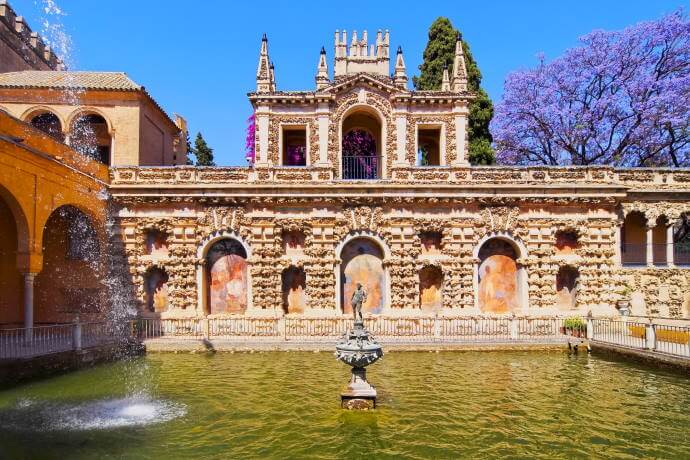
The Real Alcázar is one of the city's main tourist attractions. This royal palace built in the 10th century is one of the oldest royal residences in Europe and undoubtedly one of the most representative monuments of the city and the country. The complex that makes up the Royal Alcazar of Seville was founded in the early Middle Ages. The palace combines influences from the Arabic period to the Renaissance and Baroque periods, preserving within its walls the evolution of the city's history over the last thousand years. It is one of the oldest royal palaces still in use in Europe and was declared a World Heritage Site by UNESCO in 1987. The Real Alcázar hosts various cultural and educational activities, such as conference cycles, concerts or theater performances. Marvel at the majestic rooms and courtyards, and at the charming gardens and fountains. The gardens with Arab, Renaissance and Modern features are characterized by a great variety of plants (more than 20 000 plants belonging to at least 187 different species). It is easy to see why this place attracted the attention of the creators of the television series “Game of Thrones”, who filmed some scenes here!.
Admire the Gothic Cathedral and La Giralda
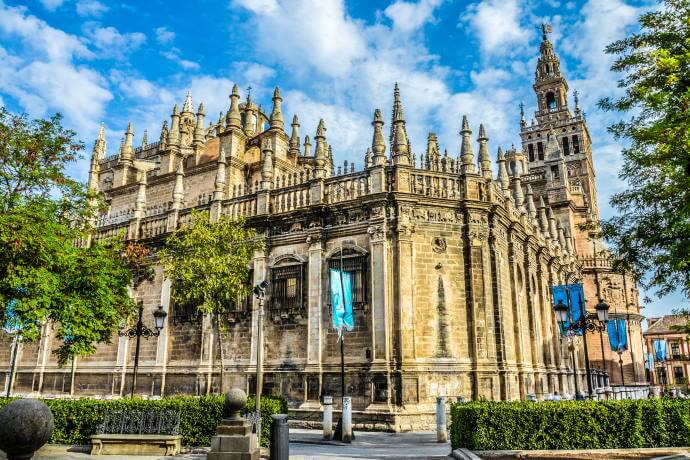
Seville is home to the largest Gothic building in the world - the Cathedral. It is the largest cathedral in Spain and one of the largest and most ornate religious buildings in the world. The Catedral de Santa María de la Sede (its official name) was built on the site where a Moorish Mosque once stood, that was taken from the Moors in 1248. After the mosque was destroyed in the 13th century, only the Patio de los Naranjos and the Giralda tower remained intact. This wonderful landmark was built during the 15th century and was declared a World Heritage Site in 1987 by UNESCO. Once inside, you will be amazed by the opulence of the interior, with its stained-glass windows and gold decoration. The tomb of Christopher Columbus, the royal chapel and the many beautiful paintings are definitely a must-see! Next to the cathedral is La Giralda, which was built in 1172 and was originally the minaret of the mosque. From this tower you have a magnificent panoramic view of the Seville skyline. This imponent tower influenced the construction of numerous towers in Spain and America. It is a true masterpiece of Almohad architecture!
Wander through Santa Cruz, the former Jewish quarter
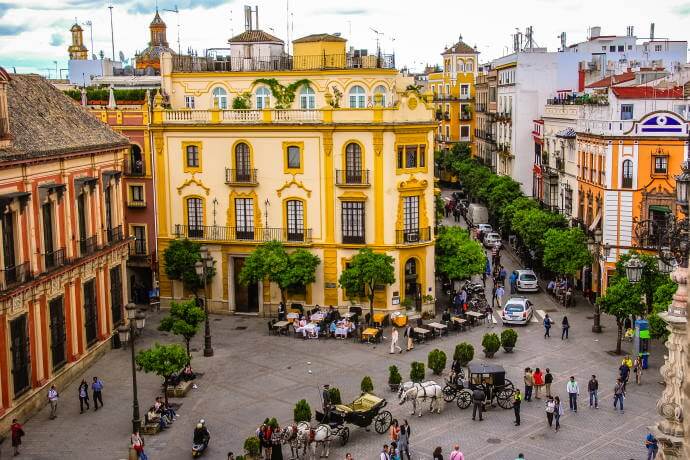
The Barrio de Santa Cruz is the touristic heart of the city of Seville. It is the former Jewish quarter of the city and is now home to several important sights, such as the Real Alcázar and the Cathedral. But Santa Cruz has much more to offer than these beautiful landmarks! This lively and medieval quarter is a maze of narrow, quaint streets and charming alleys where you will find beautiful squares and plenty of bars and restaurants. Leave the map at home and wander aimlessly through this neighborhood to immerse yourself in the history and culture of Seville. Here you will even find the narrowest street in the city, popularly known as "Calle de los Besos" (Street of Kisses). Pay attention to the historical and architectural details, try the best tapas in town, enjoy the many craft shops and take in the fantastic energy of this neighborhood! Vehicles are not allowed in almost every street of this quarter, so you can walk freely through its streets, filled with small whitewashed houses.
Taste the authentic tapas
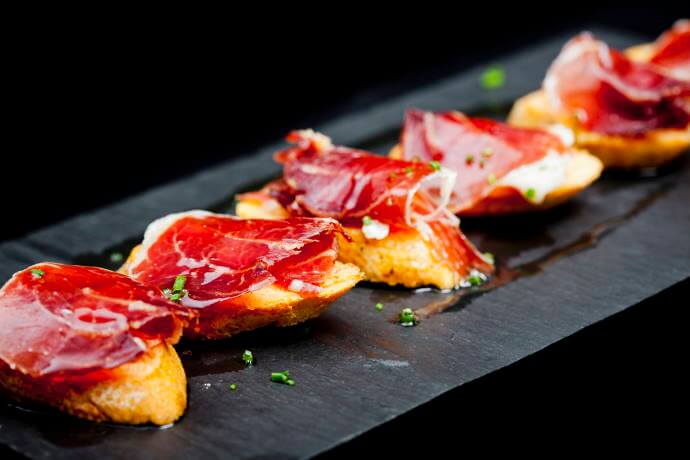
As in all of Spain, you can find delicious tapas in almost every corner of Seville, at bars and restaurants. Enjoying the flavors of Seville is also a way to learn about its culture and history! And there is a wide range of typical Andalusian dishes that you must try. Taste the popular gazpacho, a cold soup with a creamy consistency made with tomatoes, peppers and cucumbers (but other vegetables can also be used). Try the pescaíto frito, another typical and absolutely delicious dish that consists of small fish breaded in flour and fried in olive oil, usually wrapped in paper. Papas aliñás is also one of the most famous tapas in Seville - it consists of boiled potatoes that are fried and served with olive oil, vinegar, green onions and parsley. Be sure to also try pringá, another typical dish of the region. It consists of slow-cooked and shredded meat served in bread. Taste the huevos a la flamenca, a dish made with tomatoes, vegetables and eggs served in a clay pot. Some people also add ham, chorizo or bacon to this dish. Accompany your meals with a sangria or a tinto de verano, typical of the region, and be amazed by these dishes packed with striking flavors!
Go to a flamenco show
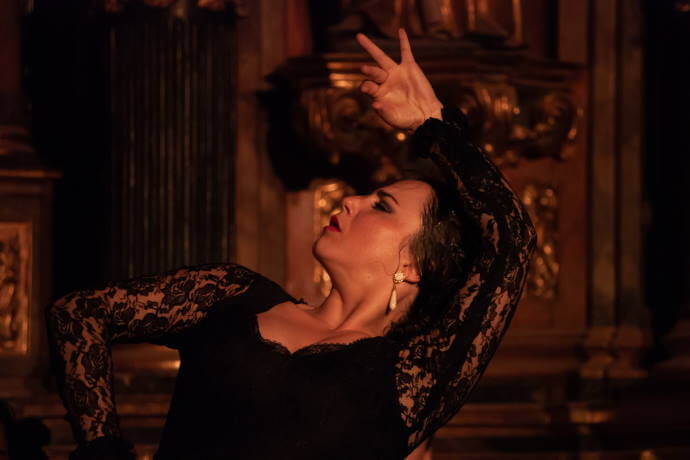
Flamenco is not only a form of song, but also a form of dance and music. It is definitely a symbol of Spanish culture and a national treasure – and that is one of the reasons why it was declared an Intangible Cultural Heritage of Humanity by UNESCO in 2010. Andalusia is the heartland of flamenco, so you can catch amazing shows in Seville. You can watch a flamenco show in a tablao, a place dedicated to this art form, or in flamenco bars, that are also dedicated to strengthening this artistic expression. Discover this amazing tradition and be swept away by the theatricality and the wide range of emotions you are about to feel!
Explore the famous Plaza de España
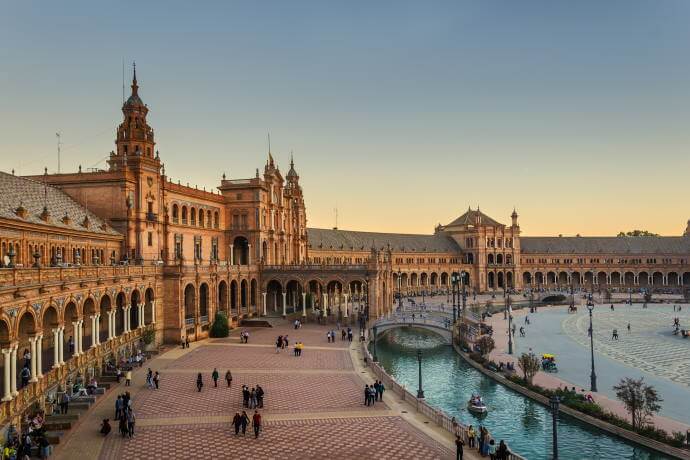
Built in 1928 as part of the Ibero-American Exhibition of 1929, the Plaza de España is a symbol of identity for Seville and for all of Spain. This majestic square is one of the city's main attractions. Unquestionably charming and imposing, the Plaza de España is a large square with a semi-elliptical shape, unique in the world, located in the María Luisa Park. This plaza represents the link between Spain and its former American territories, with the Guadalquivir River as a link. Along its perimeter runs a canal that you can cross by boat - an experience that will give you a unique perspective of the square. The architectural style is inspired by the Renaissance, with typical elements of the city, such as bricks, ceramics and wrought iron. The buildings stand out for their tiled decoration and colorful ceramics. In this square, there are two towers that stand out, one on each side of the enclosure, and, in the middle, you can see the imposing central building.
Spend a relaxing afternoon in the María Luisa Park
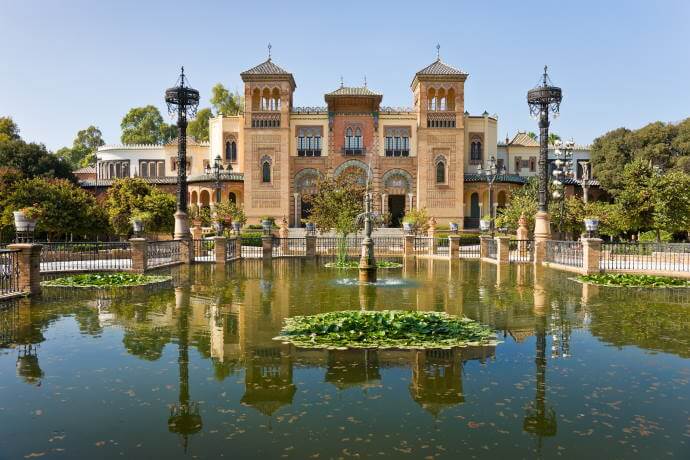
This is the largest park in Seville and it is considered the lungs of the city since it was opened in 1929 for the Ibero-American Exposition. It is definitely one of the most beautiful parks in Spain and one of the most popular places in Seville. Stretching along the Guadalquivir River and filled with indigenous and exotic botanical varieties, this public park is a testament to the city's Muslim and Christian past. Lakes, fountains, statues, pines, palm trees, orange trees, flowers, monuments, colorful mosaics and beautiful pavilions characterize this charming park. Full of magical corners, María Luisa Park is the perfect place for a change of scenery and a relaxing walk or bike ride! There is plenty of space to sit and admire every detail of this green oasis.
Stroll through the narrow streets of Triana
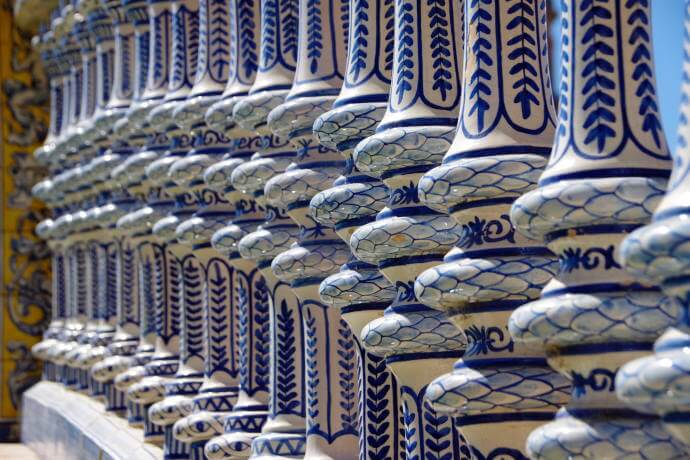
On the other side of the Guadalquivir river in Seville, you will find Triana. The best way to get to Triana is to cross the Puente Isabel II, known locally as the Puente de Triana. This neighborhood is very colorful and has a unique identity. Flamenco and bullfighting are very popular here and Triana is home to several flamenco artists, famous bullfighters, popular potters and historic sailors. It is a great place for a stroll and there are many bars in the narrow, cobbled streets where you can enjoy fantastic tapas and drinks. The colorful houses, the streets full of lively bars and the ceramic tradition shape the identity of this beautiful district. Triana is a commercial and working-class neighborhood that became famous for its azulejos (ceramic tiles) and pottery. This industry dates back to Roman times! When in Triana, be sure to visit the Church of Santa Ana, the neighborhood's most famous church. Enjoy a delicious meal at one of the many restaurants, admire the traditional architecture, and visit the Mercado de Triana, a daily fresh market where residents go to buy fruits, vegetables, meat, and fish every morning. Be sure to enjoy the vibrant nightlife on Calle Betis and attend a flamenco show! If you want to learn more about the history of Triana in relation to the pottery tradition, you can also visit the museum dedicated to this art, the Centro Cerámica.
Admire the views of the Metropol Parasol
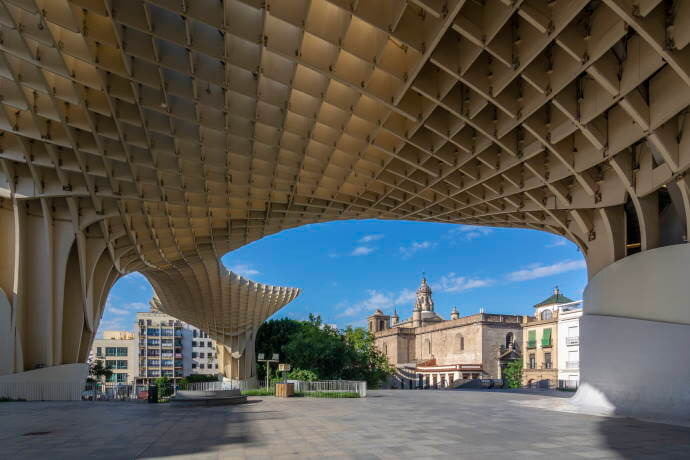
Metropol Parasol is a wooden building on La Encarnación square, in the old quarter of Seville. The building is popularly known as Las Setas de la Encarnación ("The Mushrooms of the Encarnación"), because of its shape and pillars. The original building was designed in order to bring new life to the La Encarnación square. It claims to be the largest self-sustaining wooden structure in the world. It has four floors that include the Museo Antiquarium, a central market and panoramic terraces. The Museo Antiquarium is a museum with the remains of a Roman city and a Moorish house. On the first floor you will find the central market with shops (where you can buy fish and fruit, for example), restaurants, a bar and other product stalls. The second and third floors form El Mirador, the panoramic terraces overlooking Seville. Watching the sunset from here can be an unforgettable experience! It is worth going up to watch the nightfall as the lights come on. If you are a photography lover, this is your paradise!
Walk along the river to the Torre del Oro
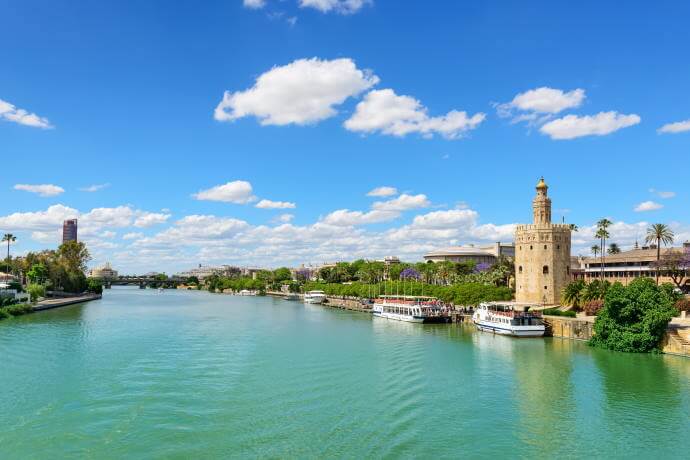
On the banks of the river Guadalquivir, you will find the Torre del Oro (the Tower of Gold). To get there, you can stroll along the river to admire the wonderful views. The Torre del Oro is a 36-meter tower, made up of three different levels, built to protect the Caliphate. It is believed that the name comes from the golden light that the tower reflects in the waters of the Guadalquivir River, although it may also refer to the prosperous times of Andalusia during the Latin American colonies. The tower once served as a prison and later as a storehouse for the riches brought back from expeditions to the New World. Today, the top floor of the tower houses the Museo Naval de Sevilla, a small museum that displays ancient naval instruments. Enjoy the wonderful view over the Guadalquivir River from this tower after a picturesque and relaxing walk!
Admire the imponent Palacio de la Condesa de Lebrija
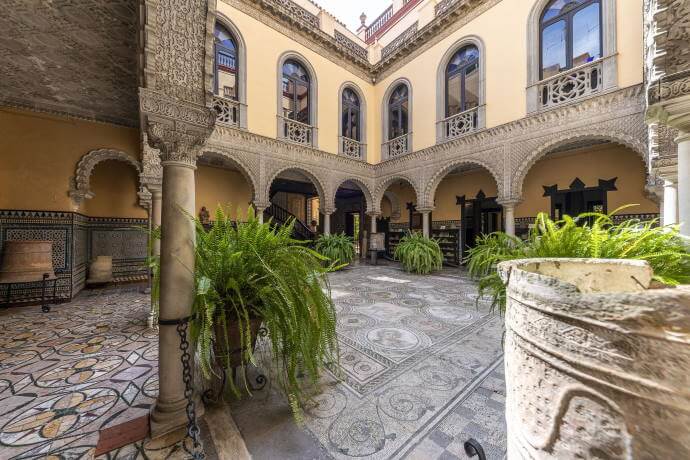
The Palacio de la Condesa de Lebrija is a 16th century palace known for one important feature: the collection of Roman mosaics that cover the floors. They are considered the most important collection of mosaics in the world! This palace is a kind of mosaic museum that came to life when Regla Manjón Mergelina, Countess of Lebrija, bought and restored the house for thirteen years. The imponent façade is typically Sevillian. The floors, made of Roman mosaics, are true artistic treasures! The halls and patios of the palace are used for conferences, galas and other events. The rooms of this imponent monument house endless priceless archaeological remains, such as vases and sculptures. Admire the architecture, the ancient mosaics, the walls and the gardens. A must for any visitor of Seville!
Visit the Acuario de Sevilla (Aquarium of Seville)
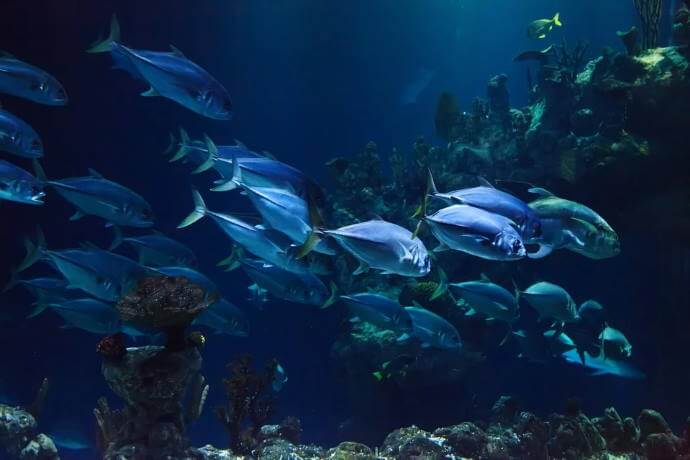
At the Aquarium of Seville, you will be able to observe fascinating marine animals from all over the world! In this aquarium, 400 different aquatic species inhabit the six themed areas: Guadalquivir, Atlantic, Rainforest, Oceanarium (one of the deepest shark aquariums in Spain), Indo-Pacific and Other Areas. The Aquarium proposes a trip that reproduces the one that Magalhães (Magellan) took around the world, using the Port of Seville as a starting point. There are also several exhibitions and activities such as the “Night with sharks”. If you want to discover the wonders of the sea of Seville, this is the perfect place to visit!
Explore the ancient Itálica
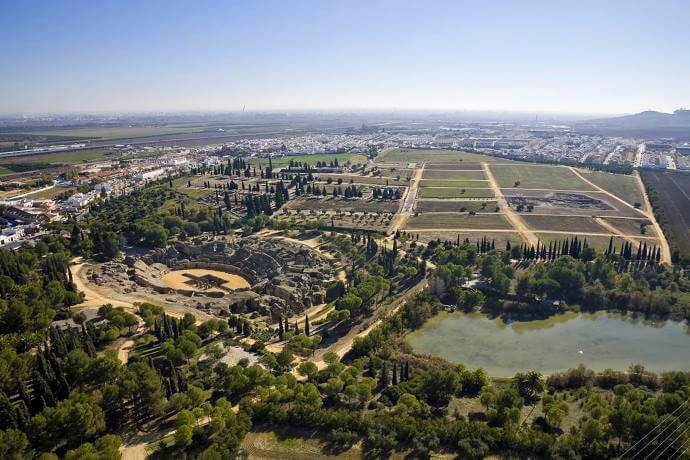
To fully understand the past and the whole history of Seville, Itálica is a mandatory stopping point! In the municipality of Santiponce, eight kilometers northwest of Seville, you will find Itálica, the first Roman city in Spain. In fact, the name Itálica indicates that the colony is of Italian origin. Founded in 206 BC, this city was the home of Roman emperors and even today this place remains a showcase for the architecture and way of life of this civilization. Itálica was the first city founded by the Roman Empire outside of Italian territory! Here you will find one of the largest amphitheaters of the Roman Empire with a capacity of 25 thousand spectators. The remarkable mosaics and the impressive amphitheater (which served as a filming location for "Game of Thrones", an American television series that recreates an epic medieval fantasy) are two of the main attractions.
Enjoy the city's festivities
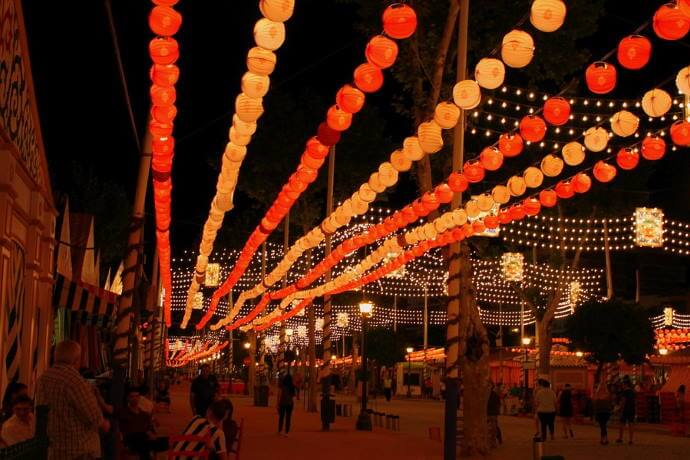
In the region of Andalusia, as in all Spain, there is a festivity called Holy Week (Semana Santa). In Seville this tradition takes on a special significance and is celebrated with great devotion. Preparations begin a year early! More than sixty guilds participate in this celebration and locals and visitors gather to watch the procession, where people appear in costume. It is a unique spectacle celebrated in the week before Easter. It is one of the biggest annual festivals in the city, the other being the Feria de Abril, which takes place two weeks later. The Feria de Abril consists of a six-day celebration with tapas, squid and other typical food on sale, various regional drinks such as manzanilla or sherry and Seville-style dancing. There is also a parade of horses and carriages and an amusement park attached to the fair. The April Fair is one of the most international and popular fiestas in Seville, with music, gastronomy and dancing taking center stage. At the fair, people wear typical Andalusian costumes. On November 1st, there is a festivity called "Tosantos" (an abbreviation of "todos los santos" or "all the saints"), that is celebrated throughout Andalusia. It is a national holiday when people from all over the country return to their hometowns to lay flowers on the graves of deceased loved ones. On this day, Seville also celebrates Día de la Cachetía in El Ronquillo. The little ones go from door to door singing and people give them walnuts, almonds, chestnuts, candy and fruit (similar to Halloween in America).
Go to Jerez de la Frontera to taste the famous wine and learn more about the horses
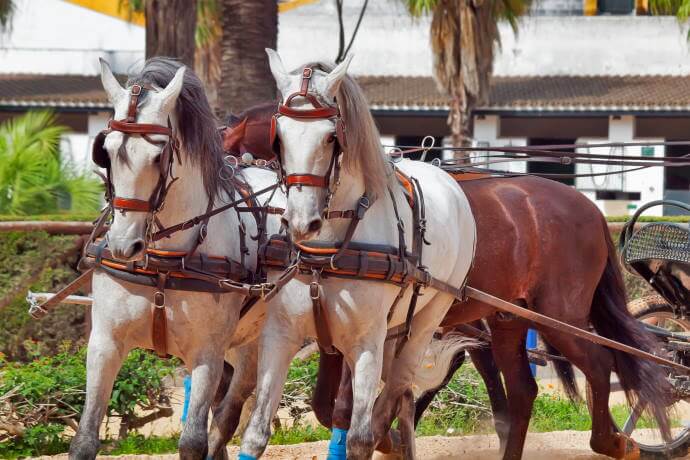
Jerez de la Frontera is one hour away from Seville, give or take, and is known for its popular fortified wine called sherry, made from white grapes, and for its ranches, where Andalusian horses and Toro Bravo bulls are raised. Sherry and the Andalusian horses are the two main attractions that make the town famous. Some of the most popular festivals in the region take place here, such as the famous Horse Fair. Jerez de la Frontera is also known for its Pueblo Blancos, mazes of whitewashed houses. In Jerez de la Frontera, you can visit the bodegas (wineries), where you can taste the different types of wine and learn how sherry is made, from grape to bottle. In this city you can also enjoy an equestrian show. Jerez de la Frontera is home to the Fundación Real Escuela Andaluza del Arte Ecuestre, famous for presenting the show “Como bailan los caballos andaluces“ (“How the Andalusian horses dance”), a choreographed spectacle with music involving highly trained thoroughbreds, led by riders dressed up in 18th-century costumes.



